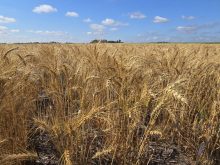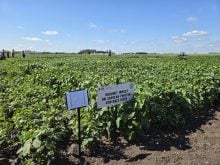Poor soil moisture and limited rainfall mean the crop could enter dormancy in poor shape, resulting in lower yields
SASKATOON — Winter wheat planting is progressing slowly in the world’s largest exporting region.
Russian farmers have only managed to seed 20.8 million acres of the crop, which is 11 per cent behind last year and the slowest pace in 11 years, according to SovEcon analyst Andrey Sizov.
Related stories:
Ukraine’s growers have planted 2.4 million acres, a 14 per cent reduction versus the same time last year.
Read Also

VIDEO: Catch up with the Western Producer Markets Desk
The Western Producer Markets Desk provides daily updates on agricultural markets, with recent video commentary including looks into canola, wheat, cattle and feed grains.
He estimates that half of Russia’s and one-quarter of Ukraine’s intended crop is in the ground.
“Seeding is delayed because of a lack of soil moisture,” Sizov said in an email.
“Russian winter wheat regions have been exceptionally dry for many months.”
Key regions in Russia have received 20 to 40 per cent of normal rainfall over the past three months.
“Some farmers plant in dust, still hoping to get rain later,” said Sizov.
The worst-case scenario is that plant growth will start next year following winter.
He is not as concerned about Ukraine because of the bigger planting window in that country.
Poor soil moisture combined with limited rainfall means the plants could enter dormancy in poor shape, resulting in lower yields.
MarketsFarm analyst Bruce Burnett said the delayed planting is a big concern in some of Russia’s northern growing regions, such as the upper Volga.
The crop needs to get established before snowfall/freeze-up, which can happen by the end of September in those areas.
Lower Volga, the southern district and parts of Ukraine have until mid-October and the Caucasus until the end of October to get the crop in the ground, so there is more time to recover.
Sizov said the risk of a poor crop is substantial in Russia’s Volga Valley, which is the third biggest winter wheat production region.
The centre region, which is the second biggest production area, still has some time. Warm weather and 10 to 20 millimetres of rain in the first half of October would help a lot.
Wheat in the top producing region in southern Russia can benefit from rain as late as early November. The same goes for Ukraine’s crop, he said.
Burnett said if there isn’t much rain in October, there will be emergence problems, spotty stands and increased chance of winterkill.
The same goes for an October cold snap, which could cut off plant growth, making the wheat weak and vulnerable to winterkill.
Drew Lerner, president of World Weather Inc., is forecasting normal precipitation in the Volga and centre regions, but below normal in the south in October.
“It is a concern, but we’ve been on this road at least three of the last four years,” he said.
“I used to get pretty worked up about it, but in three of those four years we got enough precipitation for the crop to establish well.”
In the “old days,” there would be serious risk of an October cold snap damaging the crop before it reaches dormancy, but that doesn’t seem to happen much anymore.
“As long as there’s no big, consistent cold mass coming up, I think the crop should still do alright,” said Lerner.
Burnett said all eyes in the wheat market will be focused on Russia’s weather in the coming weeks.
“The market is probably going to respond to it if we don’t get any rain over the next two to three weeks,” he said.
Sizov believes the current Black Sea weather problems are largely priced in by now.
“However, if we don’t see meaningful rain in October, the market could/should move higher to reflect that,” he said.
“For now, it’s a big problem for Russia’s Volga Valley, not the most important region. It could become a way bigger issue if plants in other areas (centre and south) will enter the winter in poor shape.”
He expects Russia’s wheat area to decline by a few percentage points, while Ukraine’s will be unchanged or decline marginally compared to last year.
Sizov estimates that 70 per cent of Russia’s and more than 90 per cent of Ukraine’s total wheat crop is winter wheat.
He said that contrary to North America, Russia and Ukraine don’t export specific classes of wheat. They just trade food or feed wheat
with required protein content. In the case of Russia, that is 12.5 per cent.
“So, in the majority of cases, it’s not important/tractable whether it’s spring wheat or winter wheat,” said Sizov.
Contact sean.pratt@producer.com
















